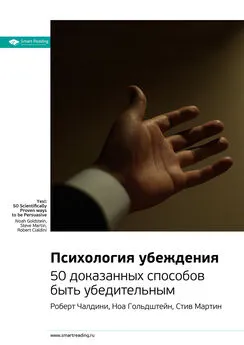Роберт Чалдини - Психология влияния
- Название:Психология влияния
- Автор:
- Жанр:
- Издательство:неизвестно
- Год:2001
- ISBN:нет данных
- Рейтинг:
- Избранное:Добавить в избранное
-
Отзывы:
-
Ваша оценка:
Роберт Чалдини - Психология влияния краткое содержание
«Психологию влияния» знают и рекомендуют в качестве одного из лучших учебных пособий по социальной психологии, конфликтологии, менеджменту все западные, а теперь уже и отечественные психологи. Книга Роберта Чалдини выдержала в США четыре издания, ее тираж превысил полтора миллиона экземпляров. Эта работа, подкупающая читателя легким стилем и эффектной подачей материала, является тем не менее серьезным трудом, в котором на самом современном научном уровне анализируются механизмы мотивации, усвоения информации и принятия решений.
Нет сомнения, что данная книга не только займет достойное место в библиотеке социального психолога, но и поможет в работе менеджерам, педагогам, политикам, всем, кто по роду деятельности должен убеждать, воздействовать, оказывать влияние.
Роберт Чалдини – профессор психологии Аризонского университета в Темпле, специалист в области экспериментальной и социальной психологии.
«Самая информативная и увлекательная работа из всех когда-либо написанных о влиянии людей друг на друга».
Дэвид Майерс, профессор психологии
«С полным основанием можно сказать, что в этой книге найдут для себя много интересного и поучительного все те, кому приходиться постоянно общаться по роду своей деятельности с широким кругом самых разных людей».
А. Л. Свенцицкий, доктор психологических наук, профессор СПбГУ
Психология влияния - читать онлайн бесплатно ознакомительный отрывок
Интервал:
Закладка:
Burger J. M. & Petty R. E. (1981). The low-ball compliance technique: Task or person commitment? Journal of Personality and Social Psychology, 40,492-500.
Burgess T. & Sales S. (1971). Attitudinal effects of «mere exposure»: A reevaluation. Journal of Experimental Social Psychology, 7,461-472.
Bum S. W. (1991). Social psychology and the stimulation of recycling behaviors: The block leader approach. Journal of Applied Social Psychology, 21, 611-629.
Bushman B.J. (1988). The effects of apparel on compliance. Personality and Social Psychology Bulletin, 14, 459-467.
Bushman B.J. & Stack A. Z). (1996). Forbidden fruit versus tainted fruit: Effects of warning labels on attraction to television violence. Journal of Experimental Psychology: Applied, 2, 207-226.
Buss D. M. (1989). Sex differences in human mate preferences. Brain and Behavioral Sciences, 12, 1-49.
Byrne D. (1971). The attraction paradigm. New York: Academic Press.
Byrne D., Rasche L. & Kelley K. (1974). When «I like you» indicates disagreement. Journal of Research in Personality, 8, 207-217.
Carducci B.J.,Dueser P. S., Bauer A., Large M., & Ramaekers M. (1989). An application of the foot-in-the-door technique to organ donation. Journal of Business and Psychology, 4, 245-249.
Castellow W. A., Wuensch K. L. & Moore С. Н. (1990). Effects of physical attractiveness of the plaintiff and defendant in sexual harassment judgments. Journal of Social Behavior and Personality, 5, 547-562.
Chaiken S. (1979). Communicator physical attractiveness and persuasion. Journal of Personality and Social Psychology, 37,1387-1397.
Chaiken S. (1987). The heuristic model of persuasion. In M. P. Zanna, J. M. Olson & C. P. Herman (Eds.), Social influence: The Ontario Symposium: Vol. 5. Hillsdale, NJ: Lawrence Erlbaum.
Chaiken S. & Stangor C. (1987). Attitudes and attitude change. In M. R. Rosenzweig & L. W. Porter (Eds.), Annual Review of Psychology (Vol. 38,575-630). Palo Alto, CA: Annual Reviews.
Chartland T. L., & BarghJ. A. (1999). The chameleon effect: The perception-behavior link and social interaction. Journal of Personality and Social Psychology, 76,893-910.
Chen S., & Chaiken S. (1999). The heuristic-systematic model in its broader context. In
5. Chaiken & Y. Trope (Eds.). Dual-process theories in social psychology (pp. 73-96). New York: Guilford.
Church A. H. (1993). Estimating the effect of incentives on mail survey response rates. Public Opinion Quarterly, 57,62-79.
Cialdini R. B. & Ascani K. (1976). Test of a concession procedure for inducing verbal, behavioral, and further compliance with a request to give blood. Journal of Applied Psychology, 61, 295-300.
Cialdini R. В., Borden R.J., Thome A., Walker M. R., Freeman S. & Sloan L. R. (1976). Basking in reflected glory: Three (football) field studies. Journal of Personality and Social Psychology, 34, 366-375.
Cialdini R. В., Cacioppo J. Т., Bassett R. & Miller J. A. (1978). Low-ball procedure for producing compliance: Commitment then cost. Journal of Personality and Social Psychology, 36, 463-476.
Cialdini R. В., Vincent J. E., Lewis S. K., Catalan J., Wheeler D. & Darby B. L. (1975). Reciprocal concessions procedure for inducing compliance: The door-in-the-face technique. Journal of Personality and Social Psychology, 31,206-215.
Clark M. S. (1984). Record keeping in two types of relationships. Journal of Personality and Social Psychology, 47, 549-557.
Clark M. S. & Mills J. (1979). Interpersonal attraction in exchange and communal relationships. Journal of Personality and Social Psychology, 37,12-24.
Clark M. S., Mills J. R. & Corcoran D. M. (1989). Keeping track of needs and inputs of friends and strangers. Personality and Social Psychology Bulletin, 15,533-542.
ClarkM. S., Mills J. & Powell M. (1986). Keeping track of needs in communal and exchange relationships. Journal of Personality and Social Psychology, 51,333-338.
Clark M. S. & Waddell B. (1985). Perceptions of exploitation in communal and exchange relationships. Journal of Personal and Social Relationships, 2,403-418.
Clark R. D., Ill & Word L E. (1972). Why don’t bystanders help? Because of ambiguity? Journal of Personality and Social Psychology, 24,392-400.
Clark R. D., Ill & Word L. E. (1974). Where is the apathetic bystander? Situational characteristics of the emergency. Journal of Personality and Social Psychology, 29,279-287.
Cohen A. (1999, May 31). Special report: Troubled kids. Time, p. 110.
Cohen M. & Davis N. (1981). Medications errors: Causes and prevention. Philadelphia: G. F. Stickley Co.
Cohen S. (1978). Environmental load and the allocation of attention. In A. BaumJ. E. Singer & S. Valins (Eds.), Advances in environmental psychology (Vol. 1), New York: Halstead Press.
Collins J. (1998, November 9). Distinct? Or extinct? Time, p. 110.
Conway M. & Ross M. (1984). Getting what you want by revising what you had. Journal of Personality and Social Psychology, 47,738-748.
Cook D. (1984). Charles de Gaulle: A biography. New York: Putnam.
Cook S. W. (1990). Toward a psychology of improving justice. Journal of Social Issues, 46, 147-161.
Craig K. D. &Prkachin K. M. ( 1978). Social modeling influences on sensory decision theory and psychophysiological indexes of pain. Journal of Personality and Social Psychology, 36, 805-815.
Darley J. M. & Latane B. (1968). Bystander intervention in emergencies: Diffusion of responsibility. Journal of Personality and Social Psychology, 8,377-383.
Davidson P. (1999, June 16). Gates speaks softly of antitrust laws. USA Today, p. B2. DaviesJ. C. (1962).Toward a theory of revolution. American Sociological Review, 27,5^19.
Davies J. C. (1962). The J-curve of rising and declining satisfactions as a cause of some great revolutions and a contained rebellion. In H. D. Graham & T. R. Gurr (Eds.), Violence in America. New York: Singet Books.
Deci E. (1975). Intrinsic motivation. New York: Plenum.
DeDreu C. K. W. & McCusker C. (1997). Gain-loss frames and cooperation in two-person social dilemmas: A transformational analysis. Journal of Personality and Social Psychology, 72,1093-1106.
De Paulo B. M., Nadler A. & Fisher J. D. (Eds.) (1983). New directions in helping: Vol. 2. Help seeking. New York: Academic Press.
Deutsch M. & Gerard H. B. (1955). A study of normative and informational social influences upon individual judgment. Journal of Abnormal and Social Psychology, 51,629-636.
DeVries D. L. & Slavin R. E. (1978). Teams-games-tournaments (TGT): Review of ten classroom experiments. Journal of Research and Development in Education, 12,28-38.
Dion К. К. (1972). Physical attractiveness and evaluation of children’s transgressions. Journal of Personality and Social Psychology, 24,207-213.
Doob A. N. & Gross A. E. (1968). Status of frustrator as an inhibitor of horn-honking response. Journal of Social Psychology, 76,213-218.
Downs A. C. & Lyons P. M. (1990). Natural observations of the links between attractiveness and initial legal judgments. Personality and Social Psychology Bulletin, 17,541-547.
Drachman D., deCarufel A. & Inkso C. A. (1978). The extra credit effect in interpersonal attraction. Journal of Experimental Social Psychology, 14,458-467.
Driscoll R., Davis K. E. & Lipetz M. E. (1972). Parental interference and romantic love: The Romeo and Juliet effect. Journal of Personality and Social Psychology, 24,1-10.
Dukes W. F. & Bavan W. (1952). Accentuation and response variability in the perception of personally relevant objects. Journal of Personality, 20,457-465.
Eagly A. H., Ashmore R. D., Makhijani M. G. & Longo L. C. (1990). What is beautiful is good, but...: A meta-analytic review of research on the physical attractiveness stereotype. Psychological Bulletin, 110,109-128.
Eagly A. H., Wood W. & Chaiken S. (1978). Causal inferences about communicators and their effect on opinion change. Journal of Personality and Social Psychology, 36,424-435.
Easterbrook J. A. (1959). The effects of emotion on cue utilization and the organization of behavior. Psychological Review, 66,183-201.
Efran M. G. & Patterson E. W.J. (1976). The politics of appearance. Unpublished manuscript, University of Toronto.
Eibl-Eibesfeldt I. (1959). Der Fisch Aspidontus taeniatus als Machahmer des Putzers La-broides dimidiatus [The fish Aspidontus taeniatus as an imitator of the cleaners Labroi-des dimidiatus]. Zeitschrift fuer Tierpsychologie, 16,19-25.
Eibl-Eibesfeldt I. (1975). Ethology: The biology of behavior (2d ed.). New York: Holt, Rine-hart & Winston.
Emswiller Т., Deaux K. & Willits J. E. (1971). Similarity, sex, and requests for small favors. Journal of Applied Social Psychology, 1,284-291.
Eron L. D. & Huesmann L. R. (1985). The role of television in the development of prosocial and antisocial behavior. In D. Olweus, M. Radke-Yarrow & J. Block (Eds.), Development of prosocial and antisocial behavior. Orlando, FL: Academic Press.
Evans F. B. (1963). American Behavioral Scientists, 6(7), 76-79.
Fazio R. H., BlascovichJ. & Driscoll, D. (1992). On the functional value of attitudes. Personality and Social Psychology Bulletin, 18,388-401.
Fazio R. H., Sherman S.J. & Hen R. M., (1982). The feature-positive effect in the self-perception process. Journal of Personality and Social Psychology, 42,404-411.
Feinberg R. A. ( 1986). Credit cards as spending facilitating stimuli. Journal of Consumer Research, 13,348-356.
Feinberg R. A. (1990). The social nature of the classical conditioning phenomena in people. Psychological Reports, 67, 331-334.
Fenigstein A., Scheier M.F. & Buss A. H. (1975). Public and private self-consciousness: Assessment and theory. Journal of Consulting and Clinical Psychology, 43,522-527.
Festinger L. (1954). A theory of social comparison processes. Human Relations, 7,117-140.
Festinger L. (1957). A theory of cognitive dissonance. Stanford: Stanford University Press.
Festinger L., Riecken H. W. & Schachter S.(1956). When prophecy fails. Minneapolis: University of Minnesota Press.
Fiske S. Т. & Neuberg S. L, (1990). A continuum of impression formation: Influences of information and motivation on attention and interpretation. In M. P. Zanna (Ed.), Advances in experimental social psychology (Vol. 23, pp. 1-74). New York: Academic Press.
Fleming T. (1997, November 23). 13 things you never knew about the American Revolution. Parade, pp. 14-15. For women, all’s pheromones in love, war. (1999, March 7). The Arizona Republic, p. E19.
Foster E. (1991, January 28). Lobbyists circle over capitol. The Arizona Republic, pp. Al, A6.
Foushee M. C. (1984). Dyads and triads at 35,000 feet: Factors affecting group process and aircraft performance. American Psychologist, 39,885-893.
Fox M. W. (1974). Concepts in ethology: Animal and human behavior. Minneapolis: University of Minnesota Press.
Freedman J. L. (1965). Long-term behavioral effects of cognitive dissonance. Journal of Experimental Social Psychology, 1,145-155.
Читать дальшеИнтервал:
Закладка:










